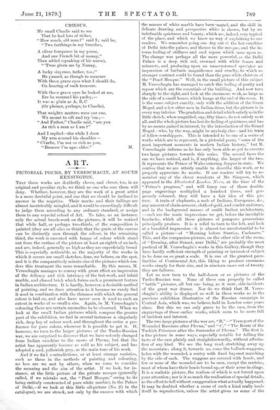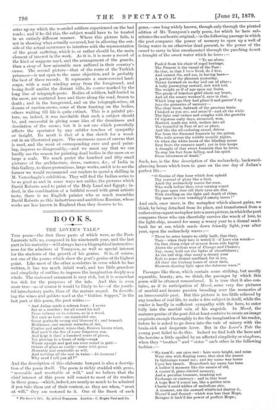ART.
PICTORIAL POEMS, BY VERESCHAGIN, AT SOUTH KENSINGTON.
THAT these works are decidedly clever, and clever, too, in an original and peculiar style, we think no one who sees them will deny. Whether, however, they are the work of a great artist is a more doubtful point, and one that we should be inclined to answer in the negative. Their merits and their failings are almost inextricably mingled, and it would be exceedingly difficult to judge them according to any ordinary standard, or assign them to any especial school of Art. To take, as an instance, only the actual brush-work on the pictures, it will be noticed that while half, or perhaps two-thirds, of the composition is painted (they are all oils) so thinly that the grain of the canvas can be distinctly seen through the colour, in the remaining third, the work is executed with lumps of colour which stand out from the surface of the picture at least an eighth of an inch, and are, indeed, generally as high as they are superficially broad This is especially noticeable, as the majority of the works in which it occurs are small sketches, done, we believe, on the spot, and it is the comparatively minute size of the pictures which ren- ders this treatment the more remarkable. By this means, M. Vereschagin manages to convey with great effect an impression of the delicacy and rich intricacy of the fret-work, and inlaid marble, and chased brick which forms such a prominent feature in Indian architecture. It is hardly, however, a desirable method of painting, and we draw attention to it because we rarely find it used in combination with the thinness with which the general colour is laid on, and also have never seen it used to such an extent in works of so small a size. Again, in M. Vereschagin's colouring there are certain anomalies to be observed. When we look at the small Indian pictures which compose the greater part of the exhibition, we find in several instances a singularly rich, deep key of colour used, and throughout the series a pre- ference for pure colour, wherever it is possible to get it. If, however, we turn to the larger pictures of the Turko-Russian war, we are surprised to discover that we have notonly changed from Indian sunshine to the snows of Plevna, but that the artist has apparently become as cold as his subject, and has adopted a cool, yellowish grey, as the main tone of his work.
And if we find contradictions, or at least strange varieties, such as these in the methods of painting and colouring, no less are we met by others, when we come to consider the meaning and the aim of the artist. If we look, for in- stance, at the little picture of the private mosque (generally called, if we mistake not, the " Pearl Mosque," owing to its being entirely constructed of pure white marble), in the Palace of Delhi,—if we look at this little oil-picture (No. 25 in the catalogue), we are struck, not only by the success with which the masses of white marble have been treated, and the skill in delicate drawing and perspective whicr is shown, but by an indefinable quietness and beauty, which ais, indeed, very typical of the place, and which we know no way sf explaining to our readers. We remember going one day out of the hot sunshine of Delhi into the palace, and thence to the mosque, and the in- tense feeling of stillness and cool repose which came upon us. The change was perhaps all the more powerful, as the Delhi Palace is a deep rich red, crowned with white domes and minarets, and producing upon an unaccustomed spectator an impression of barbaric magnificence and cruelty, to which no
stronger contrast could be found than the pure white cloisters of the " Pearl Mosque." Well, iu the small picture of this subject M. Vereschagin has managed to catch this feeling of purity and repose which are the essentials of the building. And now turn sharply to the right, and look at the enormous work, as large as the side of a small house, which hangs at the end of the room. It is the same subject exactly, only with the addition of the Great Mogul, and a few other men in Indian dress, but the picture is in every way inferior. The gradation and detail which satisfy us in the little sketch, when magnified, say, fifty times, do not satisfy us at all, and the whole picture has lost its feeling of quietness, and has by no means gained in interest, by the introduction of the Grand Mogul—who, by the way, might be anybody else—and his train of fellow-worshippers. This is intended to be one of a series of works which are to represent, in a pictorial poem, " some of the most important moments in modern Indian history," but M. Vereschagin informs us he has only been able as yet to execute two large pictures towards this series. The second faces the one we have noticed, and is, if anything, the larger of the two. It represents the Prince of Wales entering Jeypur in state. We confess that we are utterly unable to describe this work, or to properly appreciate its merits. If our readers will try to re- member any of the clever woodcuts of Mr. Simpson, which appeared in the Illustrated London News, at the time of the " Prince's progress," and will fancy one of those double- page engravings multiplied a hundred times, and gor- geously coloured, they will have a fair idea of this pic- ture. A train of elephants, a mob of Indians, Europeans,
any amount of chain-armour, cloth-of-gold, and scarlet uniforms, and in the background masses of sunlit Indian architecture, —such are the main impressions we get, before the inevitable headache, which all these pictures of pompous processions principally produce. It is a relief to turn to the left, and look at a beautiful impression—it is almost too unsubstantial to be called a picture—of " Morning before Sunrise, Cashmere." This, and the companion-picture, on the other side of the room, of " Evening, after Sunset, near Delhi," are probably the most poetical of M. Vereschagin's works in this Gallery, though they have hardly sufficient strength of painting or interest of subject. to be done on so great a scale. It is one of the greatest pecu- liarities of Continental Art, this liking to produce enormous works simply for their size, and in nineteen cases out of twenty they are failures.
Let us now turn to the half-dozen or so pictures of the Turko-Russian war. None of these can properly be called " battle " pictures, all but one being, as it were, side-incidents of the great war drama. Nor do we think that M. Veres- chagin's ability is displayed so well in these works as in the previous exhibition illustrative of the Russian campaign in Central Asia, which was, we believe, held in London some years since. But this we can only guess to be the case, from the engravings of those earlier works, which seem to be more full of incident and interest.
The two large pictures of the war are, "B,"—" Transport of the Wounded Russians after Plevna," and " C," " The Route of the Turkish Prisoners after the Surrender of Plevna." The first is a fine picture in some ways, especially notable for tolling the facts of the case plainly and straightforwardly, without affecta- tion of any kind. We see the long road, stretching away up the mountain ; along it, towards us, come the bullock-waggons, laden with the wounded, a sentry with fixed bayonet marching by the side of each. The waggons are covered with hoods, and few or none of the wounded are to be seen, except the sentries, most of whom have their heads bound up, or their arms in slings. It is a realistic picture, the realism of which is not forced upon your attention ; nor is it so much the realisation of special details, as the effort to tell without exaggeration what actually happened.. It may be doubted whether a scene of such a kind really lends itself to reproduction, unless the artist gives us some of the utter agony which the wosnded soldiers experienced on the bad roads ; and if he did this, the subject would have to be treated in an entirely different manner. Where this picture fails, is not in showing what actually occurred, bat in allowing the out- side of the actual occurrence to interfere with the representation of the great suffering, which is, or rather should be, the main element of interest in the work. As it is, it is more a record of the kind of waggons used, and the arrangement of the guards, than a story of how miserable men suffered in their country's cause. The second picture—that of the route of the Turkish prisoners—is not open to the same objection, and is probably the best of these records. It represents a snow-covered land- scape, with a road winding away from the foreground, and losing itself amidst the distant hills, its course marked by the long line of telegraph-posts. Bodies of soldiers, half-buried in the snow, are scattered here and there along the road, frozen to death ; and in the foreground, and on the telegraph-wires, sit dozens of carrion-crows, some of them feasting on the bodies, others waiting till life is quite extinct. This is a painful pic- ture, as, indeed, it was inevitable that such a subject should be, and successful in giving some idea of the dreariness and desolation of the scene ; but it is not one which powerfully affects the spectator by any subtler touches of sympathy or insight. Its merit is that of a fine sketch for a wood- cut in an illustrated paper. The enormous mass of canvas that is used, and the want of corresponding care and good paint- ing, impress us disagreeably,—and we must say that we can hardly see the reason for painting dead bodies in the snow on so large a scale. We much prefer the hundred and fifty small pictures of the architecture, dress, customs, 43c., of India in this Gallery, to these pretentious, large works, and it is to see the former we would recommend our readers to spend a shilling in M. Vereschagin's exhibition. They will find the Indian series to be as good as and in some ways not unlike, the pictures which David Roberts used to paint of the Holy Land and Egypt ; in- deed, in the combination of a faithful record with great artistic taste, there is no English painter who so much resembles David Roberts as this industrious and ambitious Russian, whose works are less known in England than they deserve to be.



































 Previous page
Previous page